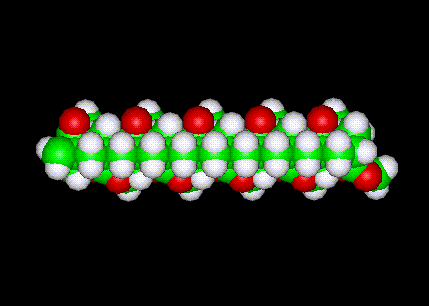Plexiglass Molecule

The Plexiglass (Methylmethacrylate) Molecule
For 3-D Structure of the Plexiglass Molecule using Jmol Click here
Perspex, which is sold in the USA as Plexiglas, is the name given to polymethyl-2-methylpropanoate, the polymer of methyl methacrylate; the material is thermoplastic, and transparent. It also is sold by the names "Acrylite" and "Lucite" and is commonly called Acrylic Glass.
The first acrylic acid was created in 1843. Methacrylic acid, derived from acrylic acid, was formulated in 1865. The reaction between methacrylic acid and methanol results in the ester methyl methacrylate. Polymethyl methacrylate was discovered in the early 1930s by British chemists Rowland Hill and John Crawford at Imperial Chemical Industries (ICI) in England. ICI registered the product under the trademark Perspex.
Plexiglass is a strong, tough, and lightweight material. It has a density of 1.17–1.20 g/cm3, which is less than half that of glass. It also has good impact strength, higher than both glass and polystyrene; however, PMMA's impact strength is still significantly lower than polycarbonate and some engineered polymers. PMMA ignites at 460 °C (860 °F) and burns, forming carbon dioxide, water, carbon monoxide and low-molecular-weight compounds, including formaldehyde.
It is often used in place of glass, though its softness leads to its being easily scratched. The material has a good degree of compatibilty with human tissue, and can be used for replacement lenses in the eye when the original lens has been removed in the treatment of cataracts. Hard contact lenses are frequently made of this material; soft contact lenses are often made of a related polymer, in which the acrylate monomers are used that contain one or more hydroxy groups to make them hydrophilic.
Perspex can be joined using cyanoacrylate cement (so-called "Superglue"), or by using liquid Acetone to dissolve the plastic at the join which then fuses and sets, forming an almost invisible weld. Perspex can also be easily polished, by which method cut edges (which turn opaque) can be returned to transparency.
Unlike glass, perspex does not filter UV (ultraviolet) light. Some manufacturers coat their perspex with UV films to add this property.